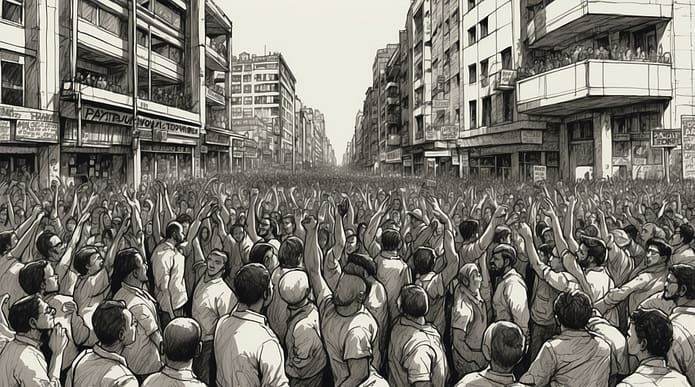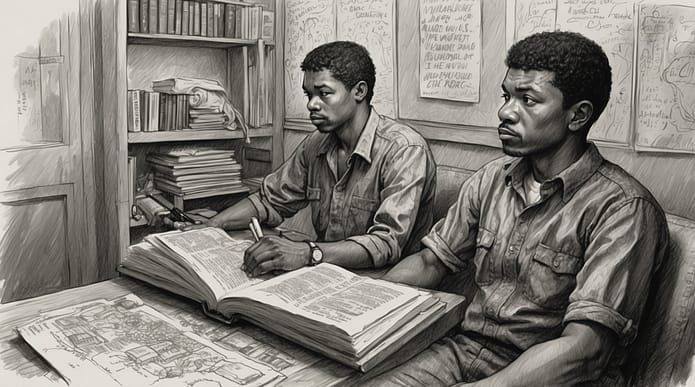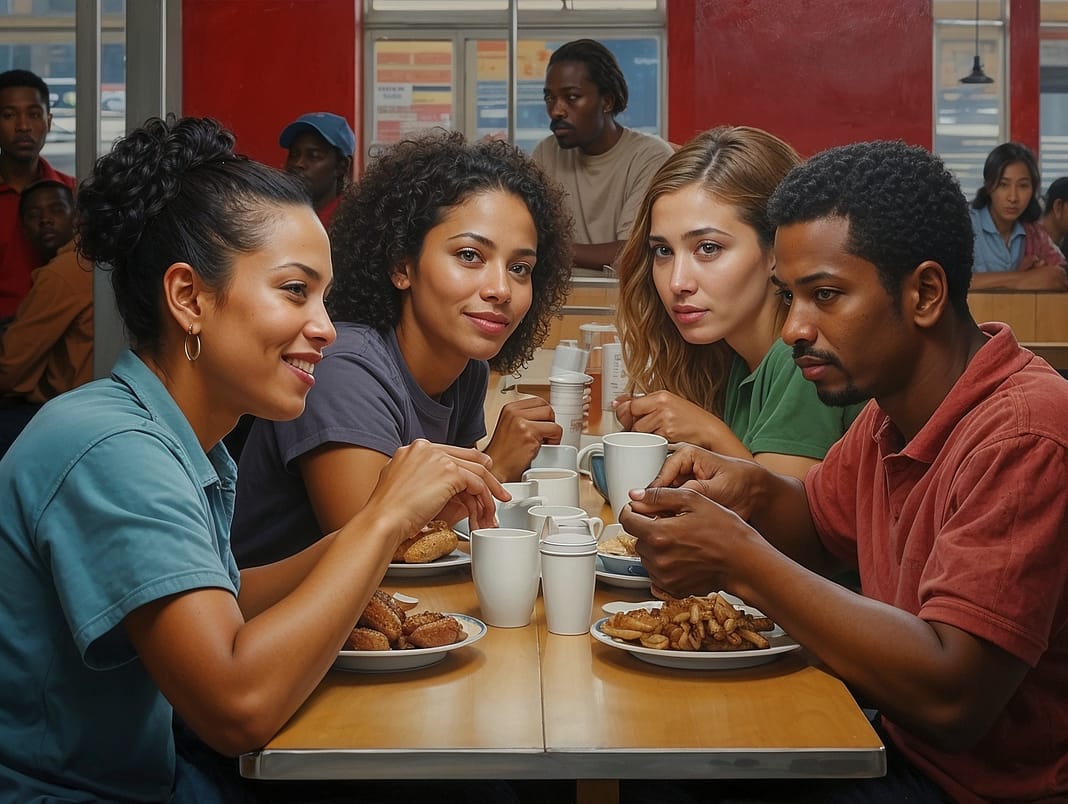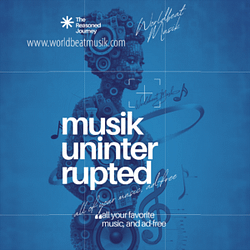I sit at the edge of a world that always seems to ask the same question, whispered beneath the hum of lunchrooms, boardrooms, and city streets: Why are all the Black kids sitting together in the cafeteria?
It’s a question as old as the gaze of the other, lingering somewhere between curiosity and discomfort, yet as present as the silent divides we still walk past today. This question doesn’t just ask why, it asks how. How do we carry ourselves in a world that watches our every move? How do we build spaces that hold the weight of our skin and history?
We are not simply sitting together because we are Black, but because there is a certain warmth in collective breath, a solace in shared stories. It is as though we are weaving a blanket thick enough to shield us from a society too often indifferent to our cries. There is power here, at these cafeteria tables, in these meetings of our quiet pain, our joy, our becoming. There is a whisper between us, saying I see you. And that, in a world that refuses to look, is everything.
But I hear the voices asking today: Is this segregation? Is this exclusion?
No, it’s not exclusion. It’s reclamation. It’s survival. When the world forces you into a mold too narrow for your spirit, you find refuge in each other, in the places where your existence is not questioned but affirmed. To be Black in this country and to be relatively conscious is to be in a rage almost all the time. The cafeteria table isn’t just where we sit—it’s where we are allowed to breathe, where the rage simmers quietly, beneath conversation and laughter, beneath stories of everyday life. We sit together not to shut others out but to remind ourselves of our wholeness.
The Weight of Self-Segregation. Finding Identity in Exile
Self-segregation speaks to something deeper—something about the way racial identity forms in the face of an overwhelming societal gaze. It is not segregation in the old sense of the word, not a refusal to integrate, but rather a balm, a way of stitching our fragmented selves together. We come together because we must; because sometimes, it is only in the presence of those who understand our unspoken wounds that we can begin to heal.

In the swirling vortex of protests, in the chants and tears and raised fists, we see this same act of gathering. It is the rage of the oppressed, but it is also the discovery of self. We are not segregating ourselves by gathering in the streets or raising our voices in unison. We are claiming space. We are saying to a world that would otherwise deny us: We exist. We will not be erased.
In these moments, our very bodies become the cafeteria tables. Our gatherings are not about exclusion but affirmation, the creation of spaces where the weight of systemic oppression can be momentarily laid down. The world asks why, as if our unity threatens its fragile structures, but the truth is simpler and more profound: we are protecting our souls.
Colorblindness. A Lie We Tell Ourselves

But the world, in its infinite discomfort with discomfort, has found a new language. It speaks of colorblindness now, pretending that race is invisible. The laws against Critical Race Theory in states like Florida and Texas are not just laws against education; they are laws against truth, against the messiness of history, against our right to look at the bloodstains on the fabric of this nation and name them for what they are. Not everything that is faced can be changed, but nothing can be changed until it is faced. And yet, here we are, trying to forget the very things we most need to confront.
This obsession with colorblindness is a refusal to reckon with our differences. It tells us that by not talking about race, we can somehow overcome it. But silence never healed a wound; it only hides the infection. Racial identity is not something we can escape simply by ignoring it. It lives in the bones of this country. It whispers through school hallways and boardrooms, through neighborhoods divided by invisible lines. Pretending not to see race is a betrayal of those who live within it every day.
What the world needs now is not blindness but clarity, not avoidance but conversation. We must ask ourselves, What are we so afraid to see?
The New Generation. Hope or Haze?
There is talk now of a new generation—of Gen Z, of the multiracial identity that complicates the framework of the past. Some say that this generation is moving beyond the old binaries, forming friendships and relationships across racial lines with ease. They point to the increasing number of interracial marriages, the rise of multiracial students in schools, and a social media culture that blends cultures and identities in ways our ancestors could hardly imagine.
But we must not mistake this progress for a complete transformation. Beneath the surface, the old wounds still bleed. The struggle for identity, for a place at the table, continues. Multiracial individuals navigate worlds that sometimes force them to choose, to identify with one part of themselves over another. They too are searching for the cafeteria table, for a place where they can sit and not have to justify their existence.
We cannot forget that even in this new world, the old lines remain. Police violence still disproportionately targets Black bodies. Economic disparities still fall along racial lines. And the question of belonging, of where we can sit and how we are seen, still looms over us.
A Call to Conversation. What Are We Afraid To Say?
And so, we are left with a lingering call—a call to conversation, not avoidance. To face the painful truths of race, of segregation, of the ways we self-protect and self-preserve. The world continues to ask, Why are all the Black kids sitting together in the cafeteria? But perhaps the better question is, What are we afraid to ask ourselves about why we notice?
The question is not about the kids at the table, but about the world that made the table necessary in the first place. We must dig deeper, feel the weight of history in our hands, confront the systems that made such separations a survival strategy.
Sitting together is an act of love, not just for each other but for ourselves. It is a way of holding space for the parts of us that the world is too afraid to touch.
And so, the cafeteria becomes a metaphor not just for racial identity but for our collective soul. It is a place where we gather to hold the pieces of ourselves that the world refuses to see. And until we can have these conversations—about race, about identity, about the deep wounds this country refuses to heal—those tables will remain, gathering us in our quiet rage and whispered hope.
The world is still asking the wrong questions. But we are here, still sitting together, still waiting for the day when the question itself no longer needs to be asked.
Discover more from The Reasoned Journey
Subscribe to get the latest posts sent to your email.


